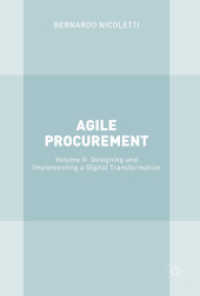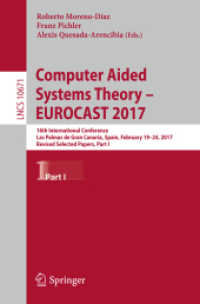- ホーム
- > 洋書
- > 英文書
- > Science / Mathematics
Full Description
Eco-toxicology, an offshoot of toxicology, is a multidisciplinary science that integrates toxicology and ecology by drawing knowledge and procedures from both fields. It analyses the effects of toxic chemicals or biological agents on living organisms at different levels of organization. Eco-toxicology classifies different contaminants, their characteristics, release and ecological fate, and predicts their effects so that timely action can be taken to prevent or minimize any detrimental effects.
Environmental Toxicology starts with the basics of toxicology, briefly touching on the sources of toxic compounds, classification of toxicants, and factors affecting toxicity, and then elaborates on heavy metal toxicity. The individual chapters on various heavy metals and radioactive metals discuss the sources and routes of exposure, aetiology, pathophysiology, clinical manifestations, and mechanisms of toxicity, toxicological effects, diagnosis, treatment, management, and ecological impact. The book covers the field in its greatest width and provides an insight into pesticide and radiation toxicity, and recent advances in eco-toxicology, with special focus on the removal of HMs and the latest bioremediation techniques.
This book serves as a reference work for advanced students pursuing degrees in environmental toxicology and across various disciplines, such as biomedical and environmental sciences, toxicology, eco-toxicology, pharmacology, public health, etc. and all interested in learning the concepts of eco-toxicology.
Features:
A systematic overview of the key concepts of eco-toxicology, its relationship with other disciplines, and recent advances in the area
Detailed classification of toxicants, types of toxicity, and mechanism of the action of toxicants
An in-depth coverage of topics on the mechanism toxicity of HMs, in addition to exclusive sections on pesticide and radiation toxicity
A fact file in each chapter, highlighting its key points
Flow charts, tables, diagrams, and illustrations in easily understandable language
Contents
Chapter 1 Introduction
Fact File
1.1 Introduction
1.2 Historical Background
1.3 Sub-Disciplines of Toxicology
1.4 Relationship with Other Disciplines
1.5 Scope of Toxicology
Chapter 2 Basics of Eco-Toxicology
Fact File
2.1 Introduction
2.2 Sources of Toxic Compounds
2.3 Classification of Toxicants
2.4 Types of Toxicity
2.5 Factors Affecting Toxicity
2.6 Dose-Response Relationship
2.7 Environmental Persistence
2.8 Toxicity Testing
Chapter 3 Heavy Metal Toxicity: An Overview
Fact File
3.1 Introduction
3.2 Sources of HMs
3.3 Basic Mechanism of Heavy Metal Contamination
3.4 Thermodynamics of HMs
3.5 HM Toxicity
Chapter 4 Heavy Metal Toxicity: Lead
Fact File
4.1 Introduction
4.2 Sources and Route of Exposure
4.3 Aetiology
4.4 Pathophysiology and Clinical Manifestations
4.5 Mechanism of Lead Toxicity
4.6 Toxicological Effects of Lead
4.7 Diagnosis
4.8 Treatment and Management of Lead Poisoning
4.9 Impact of Lead on the Environment
Chapter 5 Heavy Metal Toxicity: Arsenic
Fact File
5.1 Introduction
5.2 Sources and Routes of Exposure
5.3 Aetiology
5.4 Pathophysiology and Clinical Manifestations
5.5 Mechanism of Arsenic Toxicity
5.6 Toxicological Effects of Arsenic
5.7 Diagnosis
5.8 Impact of Arsenic on the Environment
Chapter 6 Heavy Metal Toxicity: Chromium
Fact File
6.1 Introduction
6.2 Sources and Routes of Exposure
6.3 Aetiology
6.4 Pathophysiology and Clinical Manifestations
6.5 Mechanism of Chromium Toxicity
6.6 Toxicological Effects of Chromium
6.7 Diagnosis
6.8 Treatment and Management of Chromium Poisoning
6.8 Impact of Chromium on the Environment
Chapter 7 Heavy Metal Toxicity: Mercury
Fact File
7.1 Introduction
7.2 Sources and Routes of Exposure
7.3 Aetiology
7.4 Pathophysiology and Clinical Manifestations
7.5 Mechanisms of Mercury Toxicity
7.6 Toxicological Effects of Mercury
7.7 Diagnosis
7.8 Treatment and Management of Mercury Poisoning
7.9 Impact of Mercury on the Environment
Chapter 8 Heavy Metal Toxicity: Cadmium
Fact File
8.1 Introduction
8.2 Sources and Routes of Exposure
8.3 Aetiology
8.4 Pathophysiology and Clinical Manifestations
8.5 Mechanisms of Cadmium Toxicity
8.6 Diagnosis
8.7 Treatment and Management
8.9 Impact of Cadmium on the Environment
Chapter 9 Radioactive Metals and Radiation Toxicity
Fact File
9.1 Introduction
9.2 Radioactive Elements
9.3 Sources of Radioactive Metals
9.4 Routes of Exposure of Radioactive Metals
9.5 Aetiology
9.6 Nuclear Disasters in History
9.7 Pathophysiological and Clinical Manifestations
9.8 Mechanisms of Toxicity
9.9 Diagnosis
9.10 Treatment and Management of Radioactive Metal Poisoning
9.11 Toxicological Effects of Radioactive Metals on the Environment
Chapter 10 Pesticide Toxicity
Fact File
10.1 Introduction
10.2 Classification
10.3 Toxicity of Pesticides
10.4 Impacts of Pesticides on the Environment
10.5 Diagnosing and Treating Pesticide Poisoning
10.6 Managing Pesticides
Chapter 11 Recent Advances in Remediation of Heavy Metals
Fact File
11.1 Introduction
11.2 Types of Physico-Chemical Remediation Methods
11.3 Chemical Precipitation
11.4 Nanotechnology in the Removal of HMs
11.5 Advantages and Disadvantages of Physico-Chemical Methods
Chapter 12 Bioremediation of Heavy Metals
Fact File
12.1 Introduction
12.2 Microbes Used in Bioremediation
12.3 Bioremediation Techniques
12.4 In-situ Bioremediation Techniques
12.5 Advantages and Disadvantages
12.6 Applications of Bioremediation
Chapter 13 Recent Advances in Eco-Toxicology
Fact File
13.1 Introduction
13.2 Atomic Absorption Spectroscopy (AAS)
13.3 X- Ray Fluorescence
13.4 Inductively Coupled Plasma Mass Spectrometry (ICP-MS)
13.5 Inductively Coupled Plasma Optical Emission Spectrometry (ICP-OES)
13.6 Nuclear Magnetic Resonance
13.7 Green Initiatives for Environment Management








